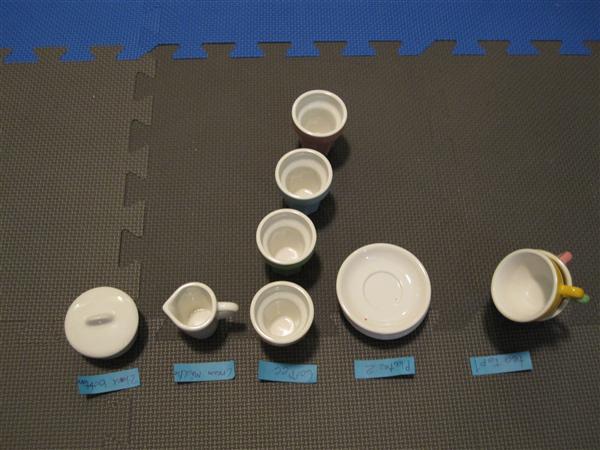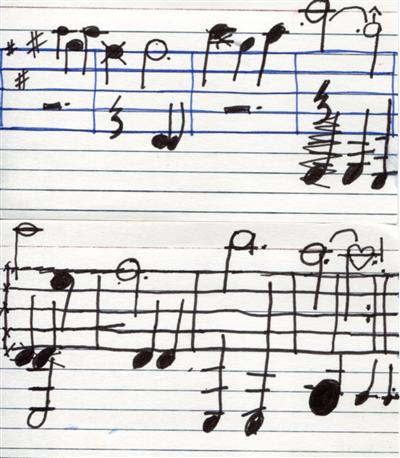Wednesday: I ease into practice today. M and I have dinner, then I head into the TV room to practice the djembe with our instructional DVD. M joins me at first, but quits pretty quickly. I keep going for a few minutes while M visits with her mom, who gets home while we are playing the djembe.
I go into the den to get ready for practice at about 6:50. M joins me and gets involved in arranging pieces of her tea set in our practice area. She wants to earn items from the tea set as awards. Each item has a different value — tea cups are 1st place, saucers are 2nd place, drinking glasses/coffee cups are 3rd place, the sugar bowl is last place (“because you don’t want to eat too much sugar and get fat”), and the creamer is in between 3rd place and last place. Here’s the setup (including post-it labels by M):
[I am reminded that when we were just starting out, she loved doing “G scale points” — she would play a G scale, and I would give her from 1 to 3 points for each note depending on how she placed her right-hand fingers. She loved being told how many points she got for a scale. It didn’t even matter if she got a low score (I would always explain which notes earned only 1 point out of the possible 3); she just liked getting some score.]
I let M take her time with it. Meanwhile, I try to play With Steady Hands. I don’t do terribly well. Since M hasn’t played it in a while, I decide we’ll work on it. First, however, she wants to do some songs in Read This First.
We’re in section 1-B now, which introduces reading notes on the 3rd and 4th string (G and D). M does a pretty good job, but I notice that her tone is still kind of snappy — she’s banging on the notes a bit. So I ask her to listen to her tone and try to play as loudly as she can without getting a “yell” tone. (Her tone yesterday on Meadow Minuet was also a snappy, yell tone much of the time.) And she does!
Then I ask to hear With Steady Hands. The first part (A1-A1-A1-A1) goes pretty well, even though she plays it a littler faster than I think is wise.
Then the structure and tone fall apart a bit. She plays B1-B2-A1 // B1-A1-A2 — that is, she skips the A2 section the first time through, and skips the B2 section the second time through.
M starts complaining that she’s hot, which is a troubling sign (it’s a method of passive-aggressive avoidance). But I offer to get her a wet washcloth while she works on the B1-B2 sections. (I gave her a choice of B1-B2 or A1-A2, since those were the trouble sections.) I ask her to pay special attention to her tone and to avoiding yell tones. (When she first played the song through, in the effort to get big on her crescendos, she had gotten way too loud and brutish.)
To my delight, while I am walking to the bathroom to get a washcloth, I can hear her play the B1-B2 sections with terrific attention and much-improved tone. I award her a teacup (1st place) because of her great effort.
We do this two more times: I ask her to play the sections while listening to her tone, and I go get her something (next, it was water to drink out of the teacup she earned).
By this point, it’s almost 7:45, and we’ve practiced for a little over 20 minutes. (The setup took a while).
I could probably get some more good practice out of her, but I decide to end then on a high note and to explain that because of her great cooperation, we are ending early. She whoops with joy. And the whole family eats fresh, ripe pineapple on the back patio.
A good day.

